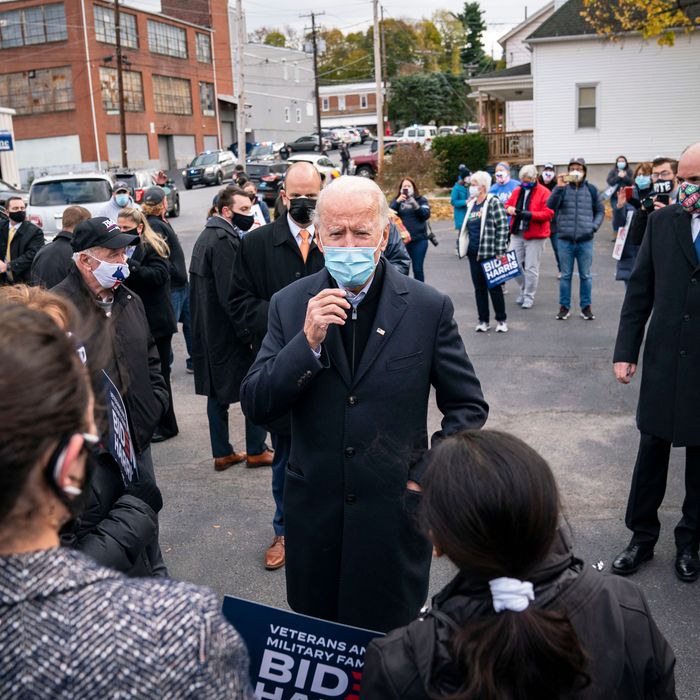
The debate in Congress over Joe Biden’s COVID-19 relief and stimulus package has mostly been characterized by the familiar dynamics of partisan polarization. Yes, Republicans have shed crocodile tears over Biden’s refusal to negotiate away his proposals. And yes, there has been a loud and sometimes angry intra-Democratic argument over whether and how to enact the $15 minimum wage provision passed by the House and stripped out by the Senate. Regardless of party, the experts have varying perspectives on what the package will and won’t accomplish in the real world.
But it’s worth speculating on what the near-certain passage of this legislation on party-line votes will mean for the newly elected president and his effort to avoid the fate of his former boss Barack Obama, who suffered a massive midterm repudiation in 2010 after succeeding in getting at least some major portions of his agenda enacted.
In Biden’s favor is the fact that his American Rescue Plan is significantly more popular than the elements of Obama’s first-year agenda. But as one shrewd veteran political observer and pollster, Stan Greenberg, argues, Biden’s package has the additional advantage of scratching a very important itch among a segment of the electorate that has been oscillating between the two parties for decades: the white working-class voters Greenberg once dubbed the “Reagan Democrats.”
In an interview with Politico, Greenberg contends that while some white working-class voters who are in full cultural panic are now regular Republicans, others only voted for Trump because he seemed more committed to their interests. He believes these Trump voters are open to a return to the Donkey Party — much like the working-class Democrats, some from suburbs like Detroit’s Macomb County, who first defected to Ronald Reagan in the 1980s:
“Trump voters, a large portion of them, want a welfare state that is dependable for working people,” says Greenberg. And Biden’s proposed $1.9 trillion Covid relief package could make a tangible difference in their lives. Do the Reagan Democrats stick with non-Trump Republicans if Biden’s Democrats deliver reopened schools, a strong economy, a huge investment in infrastructure and a $3,600-per-child benefit to families on top of a $1,400 stimulus check?
The possibility of Democrats reversing their long downward trajectory of support from white working-class voters is reinforced by Biden’s peculiar strengths. On the one hand, he’s perceived as a “centrist” who isn’t alarming to upper-income suburban swing voters who might have hesitated to vote for a Bernie Sanders. On the other, his own authentic blue-collar roots — and his ability to empathize (in a way, say, Hillary Clinton struggled to do) with those struggling with the consequences of globalization — give him an audience among non-college-educated white voters that the kind of direct assistance he’s now offering could turn into actual votes. Yes, there’s a racist element of the white working class that’s no longer reachable for any Democrats. But others are in the balance. After all, many of them voted for Barack Obama, as Greenberg points out:
In the end, these Reagan Democrats voted for Obama. It was competitive in ’08 and ’12, but when you listened to these voters, they decided Barack Obama was not Jesse Jackson: He was not a candidate they saw as running to represent “his people.” They thought he would fight for all Americans, and they ultimately voted for him — which is pretty astonishing. What they were most concerned about was NAFTA, corporations sending jobs to Mexico, CEOs enriching themselves and not investing in their own companies. They were incredibly focused on globalization. They were on the front lines of people angry about what was happening with corporate America, and were voting for Democrats — and for Obama, specifically — because they thought he would take up those issues.
Biden should have at least a good a shot at this counterintuitive appeal as did Obama, and if he delivers tangible benefits, 2022 should not resemble 2010, if only because many potential Republican voters may not be as super-energized as they were back then, or even last year. The fact that Biden’s bond with minority voters (or at least Black voters) is nearly as strong as Obama’s will help ensure he’s not trading one bloc of voters for another, and building a new coalition, not betraying his old one.
It’s in this context that the arguments about “targeting” benefits in the COVID-19 bill should be understood. It’s often assumed that swing voters are mostly concerned about avoiding too much government spending and would support efforts to reduce the price tag of stimulus measures by “targeting” them to the neediest of Americans. The swing voters Stan Greenberg is talking about — and that’s he’s studied closely since the 1980s — are most concerned that their own strongly felt needs are addressed. It’s the perception that Democrats no longer care about them that is the problem, not resentment that Democrats care about minority Americans as well.
In today’s intensely competitive political environment, it won’t take that many converts to give Democrats an edge going forward. If they can hang onto the higher share of college-educated suburbanites that Trump alienated (and Trump’s continuing grip on the GOP may help them) while “delivering” for both white and minority low-to-moderate income voters as well, Biden could lance the boil of anti-government sentiment and put Republicans on their heels in 2022 and beyond. Passage of the American Rescue Act is an essential first step.
"help" - Google News
March 07, 2021 at 01:18AM
https://ift.tt/30kTtFO
The COVID-19 Stimulus Bill Can Help Biden Transform Politics - New York Magazine
"help" - Google News
https://ift.tt/2SmRddm
Bagikan Berita Ini















0 Response to "The COVID-19 Stimulus Bill Can Help Biden Transform Politics - New York Magazine"
Post a Comment